
The Doorway Effect – Trauma Makes You Forget So Much
The Doorway Effect – Crossing a Boundary and Its Neurological Effects on Normal People and Traumatized Scam Victims
Primary Category: Psychology / Neurology
Authors:
• Vianey Gonzalez B.Sc(Psych) – Licensed Psychologist, Specialty in Crime Victim Trauma Therapy, Neuropsychologist, Certified Deception Professional, Psychology Advisory Panel & Director of the Society of Citizens Against Relationship Scams Inc.
• Tim McGuinness, Ph.D., DFin, MCPO, MAnth – Anthropologist, Scientist, Polymath, Director of the Society of Citizens Against Relationship Scams Inc.
Author Biographies Below
About This Article
The “doorway effect” describes a normal memory reset that happens at thresholds, both physical and emotional. After trauma, this reset can feel stronger, because the nervous system stays on alert and ties memory tightly to context. Scammers may exploit rapid switches between platforms, roles, and locations to fracture attention and soften boundaries. Practical anchors reduce that risk. A visible rule, a short pause, and independent verification carry a plan across scenes. Routines that protect sleep, food, hydration, and light movement support working memory, while brief grounding steps repair focus when a trigger opens a mental doorway. Support from trusted people, written checklists, and one stable channel for important tasks adds continuity. With steady practice, intention begins to travel with you, which protects safety, preserves dignity, and makes recovery work more manageable.
Note: This article is intended for informational purposes and does not replace professional medical advice. If you are experiencing distress, please consult a qualified mental health professional.

The Doorway Effect – Crossing a Boundary and Its Neurological Effects on Normal People and Traumatized Scam Victims
You may have wondered about this your whole life, but the “Doorway Effect” is often the cause of forgetfulness, not old age.
The “doorway effect” refers to a well-documented memory glitch where walking through a doorway disrupts recall of what you intended to do or fetch. Crossing a threshold signals a context change to the brain, which updates its internal “event model.” That update can weaken access to the information held in the prior room’s context (short-term memory), so the purpose for the trip fades until the original context returns.
In practical terms, when you leave the kitchen to get an item from the bedroom, the intention sits in a short-lived, context-tied state. The act of entering a new space prompts the brain to prioritize new cues, and the intention often slips away. Returning to the original room, or briefly visualizing it, often brings the intention back because the original context reactivates related memory networks.
Simple habits can reduce the effect. Saying the intention aloud before moving, carrying a visual cue, or writing a short note anchors the goal across contexts. Pausing in the new room, taking a slow breath, and picturing the starting room can also restore the plan, which keeps small tasks from stalling your day.
The Doorway Effect and the Traumatized Brain
After serious emotional trauma, the brain often stays on alert. That high-alert state ties memory more tightly to context, so the “doorway effect” can grow stronger. A simple room change may feel like a context switch big enough to interrupt working memory. The plan that felt clear in one space can fade after a threshold, especially when heart rate runs high or sleep runs short.
Hypervigilance, rumination, and dissociation also play a role. When attention scans for safety threats, fewer resources remain to hold a fragile intention, such as getting a document or calling a friend. Rumination fills working memory with replayed scenes and what-ifs, which leaves little room for the small task that began the trip. During dissociative moments, the sense of continuity drops, so the new room feels disconnected from the reason for arriving there. In this mix, the forgotten purpose is not a flaw in character. It reflects a nervous system that learned to protect through speed and constant scanning.
Triggers in the new space can add load. A sound, a photo, or a message may pull attention to old injuries, and the original plan slips further away. Fatigue, dehydration, low blood sugar, and pain can amplify these lapses by lowering focus and shortening the mental buffer that holds a goal across settings.
Several calming and organizing habits may reduce these slips. Speaking the intention quietly before moving, or writing a short phrase on a small card or phone note, can anchor the goal across rooms. A brief pause at the new doorway, one slow exhale, and a quick picture in the mind of the starting room often reconnects the context. Carrying a simple visual cue, such as the empty mug that needs a refill, can also help. Consistent routines, regular meals, enough water, and steady sleep tend to strengthen working memory, which makes these transitions easier to manage during recovery.
Neurologically, How It Works
When you cross a doorway, the brain often treats that threshold as the end of one event or period and the start of another. This process comes from how memory systems divide experience into chunks so the right details are stored with the right context. The hippocampus, which helps bind people, places, and goals into a single memory, updates its map when a boundary appears. Walls, doorframes, lighting changes, and shifts in sound act as boundary cues. Specialized “boundary” and grid cells in the entorhinal–hippocampal network fire near edges and transitions, which tells the system that a new scene has begun. That signal promotes “pattern separation,” so the brain reduces interference between the room just left and the room just entered.
Working memory sits in the prefrontal cortex and holds the immediate goal, such as getting keys or sending a text. At a doorway, attention briefly reorients to the new space. Visual regions process new layouts, the parahippocampal place area registers the scene, and the basal ganglia help “gate” what stays in the mental workspace. If the brain labels the threshold as a context change, the previous goal can lose priority. The hippocampus starts indexing new details from the current room, and the fragile intention from the prior room can slip unless it gets refreshed.
Neurochemistry shapes this switch. Novelty and context shifts release small bursts of norepinephrine from the locus coeruleus, which sharpens attention to the new scene, and can move focus away from the old task. Acetylcholine supports encoding of the current environment, which again favors the here-and-now over the just-before. These normal shifts help everyday function, since separating events prevents mix-ups, yet they also explain why a purpose in mind can vanish after stepping through a door.
Stress and load increase the effect. If heart rate runs high, sleep is short, or several tasks compete at once, prefrontal circuits have less capacity to refresh the intention. The doorway then becomes a stronger “event boundary,” so the hippocampus commits to the new segment, and the plan formed in the prior room fades. Pain, hunger, or dehydration can further weaken working memory, which makes the handoff between rooms less reliable.
Simple actions may steady this handoff. Briefly restating the goal before moving, touching, or carrying a related object, or pausing at the new threshold to recall the previous scene can rebind the intention to the new context. Regular sleep, steady meals, light movement, and calmer sensory environments support prefrontal and hippocampal function, which improves these moment-to-moment transitions. The doorway effect is not a flaw. It reflects a healthy memory system that protects clarity by segmenting life into scenes, and it can be managed by giving the brain a clear cue to carry the goal forward.
How this Evolved Within Us
In everyday life, you move through spaces that signal new opportunities and new risks. The brain treats doorways as event boundaries so memory can sort what matters in each setting. This scene-by-scene storage helps you remember where food, tools, allies, or threats were found without mixing details from the last place. By resetting context at thresholds, the system reduces interference, strengthens location-specific learning, and improves speed when deciding what action fits the new room, path, or clearing.
Ancestral environments rewarded fast reorientation. Entering a cave, stepping into tall grass, or crossing a riverbank changed light, sound, smells, and available cover. The “doorway effect” likely supported survival by shifting attention to fresh localized information, updating maps of safe routes and hidden dangers, and prioritizing planning for the space now occupied. Briefly downshifting the previous goal created a tradeoff: a small chance of losing a minor intention, in exchange for a larger gain in vigilance, adaptability, and accuracy.
Social life also benefited. New spaces often meant different norms, leaders, and resources. Event boundaries helped you track who held authority in a camp, where shared goods were stored, and which behaviors signaled welcome or warning. Today, the same mechanism explains why a purpose can fade after crossing a threshold. Rather than a flaw, it reflects an efficient strategy: segment experience, bind memories to place, and focus on the immediate environment. Pausing to restate your goal as you enter a new space gives the brain a clear cue to carry that intention forward while keeping the adaptive advantage of rapid context switching.
How the Doorway Effect Shows Up During a Scam
When attention crosses a boundary, the brain often treats the new space as a new event. Moving from a dating site to a private chat, switching from text to a call, opening a banking app, or walking into a store each creates a fresh mental scene. Intention from the prior scene can fade, short-term memory can reset, and red flags that felt clear a minute ago can soften. Urgency, affection, or authority may feel more convincing inside the new scene, because the mind is now focused on the immediate cues, not the full history.
How Scammers May Exploit the Doorway Effect
Offenders often engineer frequent context shifts. A typical sequence starts with a warm exchange on a platform, then a nudge to “move to WhatsApp”, followed by a “verification step” on a new site, then a phone call, then a request to open a wallet or banking app. Each switch functions as a doorway, which makes it easier to accept new claims, forget earlier limits, and suspend doubt. They also pair transitions with scripts that heighten arousal, such as “limited-time offer”, “urgent security check”, or “I trust only private channels”. When stepping into a physical location, such as a gift-card aisle or a cryptocurrency kiosk, the sensory change can deepen the new scene, while the scammer keeps a running phone or chat connection to hold attention inside their story.
Role changes create doorways as well. A “senior advisor” may join the chat, an “internal auditor” may take over the call, or a “courier” may text instructions. Each handoff signals a new event, which can reset skepticism and invite compliance. Even small thresholds, such as switching tabs, entering a code, or opening a “confirmation page”, can segment memory and reduce carry-over of earlier warnings. The rapid sequence of doorways increases cognitive load, narrows focus to the next step, and makes it more likely that boundaries slip.
The Doorway Effect on Scam Victim Recovery
In recovery, the “doorway effect” can interrupt memory and intention when moving between settings or tasks. Walking from a bedroom to a kitchen, switching from a journal to a phone, or moving from a therapy room to a parking lot, returning after a support zoom call, can all create a new mental scene. The earlier goal may fade, which makes it harder to hold boundaries, follow plans, and finish small steps that usually support healing.
Where It Shows Up
During appointments, a clear plan can blur by the time the car starts. After a supportive call, a shift to social media can lead to scrolling that reactivates urges or grief. Entering a bank branch or a store may revive scam memories, so focus narrows and the body speeds up. Each threshold functions like a reset, which can scatter attention and drain energy needed for routine care.
Risks During Early Recovery
Early weeks often bring high arousal, poor sleep, and strong emotions, so scene changes carry extra weight. A doorway can pair with a trigger, and a wave of shame or anger can replace a careful plan. This may lead to missed meals, skipped notes, or abandoned tasks. If a message arrives during a transition, the combination of urgency and a fresh scene can pull attention away from verification habits that normally feel solid.
Ways To Keep Intention Across Doorways
Before changing spaces, a brief anchor helps the next scene remember the last one. A single sentence on a lock screen or note card, written as a rule, keeps the plan visible, for example, “No money, no codes, no remote access.” A short routine before moving, such as three slow exhales and a quick glance at the anchor, strengthens carryover. When switching to a public place, quietly state the purpose, for example, “Deposit the check, ask one question, leave.” After arriving in a new room, pause, settle your shoulders and jaw, look around, and name three neutral objects. This simple sequence tells the nervous system that the plan continues here.
Support From Structure And People
Calendars, checklists, and brief texts to a trusted person can bridge scenes. Writing the next two steps before standing up, then reading them aloud after entering the next space, preserves continuity. When leaving therapy, take a photo of the top three takeaways, then review it in the hallway or car. If a strong wave of emotion or a trigger appears in a new setting, name it, breathe out longer than in, and return to the anchor sentence. Small rituals at doorways, such as touching a key ring or reading one line, create consistent cues that help the brain link scenes.
Markers Of Progress
Progress often shows as steadier follow-through after transitions. Plans survive the walk to the kitchen, the drive home, and the login to a laptop. Fewer impulse checks occur during context shifts, and verification habits appear even when a request arrives in a new channel. Sleep, meals, and short walks happen on time despite scene changes. These quiet gains signal that intention now crosses doorways with you, which reduces risk, protects dignity, and supports recovery.
How Emotional Triggers Can Serve as a Doorway Also
Emotional spikes can act like doorways in the mind. When shame, anger, fear, or sudden longing rises, the brain treats that feeling as a new scene. Attention narrows, memory of the last plan fades, and the body shifts into threat-readiness. A careful intention, such as calling a bank, finishing a worksheet, or staying off a risky platform, can disappear as the trigger opens a fresh mental room.
How Emotional Doorways Work
A strong cue, an image, a phrase, a smell, or a notification can switch the active goal set. The brain prioritizes survival information, so a surge of shame or alarm often overrides quieter plans. Heart rate climbs, muscles tense, and thought patterns tilt toward all-or-nothing conclusions. In this state, a message that would normally be ignored can feel urgent, a simple boundary can feel unfair, and a small delay can feel like rejection. The feeling becomes the room, and the last intention stays behind the door.
Where They Appear in Daily Life
Triggers often link to places, times, and routines. A late-night quiet house, an anniversary date, a favorite song, an unexpected “unknown caller,” or a news story can open a mental doorway. Even progress can trigger a doorway when a good day brings grief for what was lost. During these shifts, hands may reach for a phone, a feed, or a contact without the usual pause, as if the body stepped across a threshold on its own.
Risks During Recovery
Early recovery brings higher arousal and lighter sleep, so doorway effects carry extra weight. Emotional doorways can lead to unfinished tasks, missed meals, dropped verification routines, or renewed contact with unsafe people. The cost often arrives later as shame, which then triggers another doorway, and the loop continues. Recognizing the pattern reduces blame and turns attention to practical skills.
Ways to Carry Intention Through Emotional Doorways
An external cue helps the next scene remember the last plan. A visible “anchor sentence” on a lock screen or card, written as a rule, keeps boundaries present, for example, “No money, no codes, no remote access.” Before acting inside a strong feeling, three slow exhales, relaxed jaw and shoulders, and naming the state, “a shame wave,” “anger is here”, can lower intensity and restore choice. A brief script that pairs impact and next step protects dignity and direction, for example, “Feeling overwhelmed; I will stand, breathe, and read my anchor.” When triggers repeat, a short ritual at known hotspots, doorways, desks, car seats, creates continuity: touch the note, read it, then proceed.
Linking People and Structure
Trusted contacts can serve as bridges across emotional rooms. A two-sentence text to a supportive person, a calendar reminder that repeats the anchor, and a post-appointment photo of the top three takeaways keep intentions alive. Written agreements at home and work, clear response windows, simple choices, and planned cool-downs, reduce flashpoints during triggered states. When the wave passes, a quick notebook or journal entry that lists what happened, what feeling showed up, and what helped turns the episode into learning rather than proof of failure.
Signs of Progress
Progress shows as plans that survive strong feelings. The pause appears before a reply, the anchor gets read, and verification steps still happen. Words shift from global claims to specific observations, such as “pressure is high; I will slow the choice.” Sleep steadies, meals become regular, and short walks follow tense moments. These quiet gains mean emotional triggers still open doors, yet intentions now walk through with you, which protects safety, preserves dignity, and supports recovery.
Ways to Reduce Risk Created by Doorways
Simple anchors help intention survive a transition. A single written sentence that stays visible, such as “no money, no codes, no remote access,” keeps the prior goal active as contexts change. Before leaving one space for another, a brief pause, three slow exhales, and a quick look at that sentence can refresh the original boundary. Keeping one consistent channel for communication, avoiding unscheduled handoffs, and verifying identities only through official, public contact pages can lower the number of doorways that offenders control. When a change of context is unavoidable, asking a trusted person to stay connected on the call, or stepping outside and reading the anchor sentence aloud, can restore continuity.
Dr. Tim’s solution – as you leave a room, look back into it to join the two contexts together and then you are about to remember why you came!
In digital settings, doorways appear as app switches, new browser tabs, fresh log-in prompts, and sudden requests to move from email to text to a different platform. Reducing switches lowers risk. One safe device for money tasks, separate from social media and messaging, can keep financial decisions out of the pressure stream. Reading the anchor sentence before opening a banking app, then again before approving any request, keeps memory aligned with values. When a contact pushes for a platform change, a simple reply that states the rule, such as “I keep all communication here for safety,” can stop a scripted escalation. If pressure continues, ending the exchange and returning only through verified, public channels protects attention and records.
A common manifestation of this is switching between browser tabs; this is notorious for disrupting your intention and causing you to lose the thread of your thoughts.
Physical environments also influence memory and judgment. Approaching a checkout, a kiosk, or a bank desk while quietly naming the intention, for example, “I am not buying gift cards for someone I have not met,” brings the earlier rule into the new scene. Carrying one small card with the anchor sentence, and placing it near a wallet or phone, turns that rule into a visible cue at the exact moment decisions happen. If a request cannot be verified in a calm, independent way, the safer move is to delay, exit the space, and check with a bank, a friend, or a known authority. Short, prepared phrases help in these moments, such as “I only act after independent verification,” or “I decide after a 24-hour wait.” Clear words like these lower adrenaline, set expectations, and create time for a cooler review.
Rituals that bridge doorways help the nervous system keep track of purpose. A brief “before and after” routine can include one slow exhale, a glance at the anchor sentence, and a quick note on paper that names the next safe step. Keeping decisions inside daylight hours, and avoiding money choices late at night, reduces the impact of fatigue, hunger, and isolation. When strong emotion rises, labeling the state, such as “a pressure wave is here,” then changing posture, standing up, and taking three slow breaths, often resets attention. A short walk or a sip of water can complete the reset and restore judgment.
Support from trusted people strengthens these habits. Letting one person know the anchor sentence, asking them to review unusual requests, and agreeing on a simple check-in before any transfer creates a shared safety net. Written verification steps posted near a computer, along with a printed list of official contact numbers, reduce reliance on memory during stress. These steady routines keep memory linked across doorways, preserve judgment during fast switches, and limit the power of scripted transitions that offenders design to fracture attention.
Conclusion
In daily life, thresholds appear in small and large ways. A hallway, a login, a new voice on a call, or a strong feeling can act like a doorway that resets attention. Clear anchors help intention survive those switches. A short rule on a card or lock screen, spoken quietly before changing rooms or apps, may carry the plan forward. A brief pause, three slow exhales, relaxed shoulders, and a quick glance at a reminder often return your focus to your intention.
Steady routines strengthen memory across scenes. Regular sleep, consistent meals, enough water, daylight activities, and calmer evenings support the circuits that hold a goal from one place to the next. When a request arrives during a transition, simple verification steps protect judgment. Independent phone numbers, official websites, and daylight hours add time, records, and clarity.
Support makes the bridge stronger. Sharing the anchor sentence with a trusted person, agreeing on a quick check before money moves, and keeping one communication channel for important tasks create a safety net when attention feels thin. If a trigger opens a mental doorway, naming the state, standing up, and breathing out longer than in can reduce the surge. Returning to the written rule restores direction without shame.
Progress often looks quiet. Plans begin to survive the walk, the app switch, and the store aisle. Fewer impulse checks slip through, and boundaries hold even when the scene changes. With practice, intention crosses doorways with you. Safety grows, dignity holds, and daily life feels steadier, one clear sentence and one calm breath at a time.

Glossary
- Anchor sentence — A short, written rule that carries your intention across rooms, apps, or tasks. Keeping it visible on a card or lock screen helps the plan survive context changes, delays, and pressure. Reading it before and after a switch restores focus and reduces risk.
- Autonomic arousal — The body’s alert system that speeds heart rate, tightens muscles, and narrows attention under stress. During transitions, high arousal makes intentions easier to drop and hurried choices more likely. Calming breaths and posture resets lower this load.
- Basal ganglia — A set of brain structures that help “gate” what stays in working memory. During a doorway or app switch, this system may prioritize new cues and let the prior goal slip. A quick pause and restated plan keep the right task on deck.
- Boundary cells — Neurons that fire near physical edges, like walls or doorframes. Their activity helps the brain mark the start of a new scene, which can weaken recall of a plan formed in the last room. Naming the goal at the threshold counters this shift.
- Boundary cues — Signals such as a doorway, lighting change, or a new voice that tell the brain a new scene has begun. These cues can reset attention and disrupt fragile intentions. A visible reminder or spoken rule keeps continuity.
- Cognitive load — The amount of mental effort in use at a given moment. High load from multitasking, fatigue, or strong feelings makes dropped intentions more likely at transitions. Reducing switches and using checklists protects attention.
- Co-regulation — The way two people help each other calm and focus by using steady tone, paced speech, and simple steps. Asking a trusted person to stay on a call during a risky switch bridges scenes. Shared anchors strengthen follow-through.
- Context cue — Any detail that links memory to a place or state, like a smell, a sound, or a screen layout. When the cue changes, recall can fade. Recreating one cue, such as visualizing the prior room, often brings the intention back.
- Context switch — Moving from one room, app, role, or task to another. Each switch can act like a doorway that resets attention. Planning the next two steps before moving lowers errors.
- Dissociation — A temporary sense of disconnection from self, place, or time. Transitions can trigger this state, which scatters memory and intention. Gentle grounding, such as naming three neutral objects, restores contact with the task.
- Doorway effect — A normal memory reset that happens at thresholds and scene changes. The brain updates its internal “event model,” which can sideline the plan formed in the prior scene. Briefly restating the goal helps carry it forward.
- Emotional doorway — A strong feeling, like shame, fear, or sudden longing, that acts like a mental threshold. The feeling becomes the “new room,” and the last plan fades. Naming the state, then reading the anchor sentence, restores choice.
- Entorhinal–hippocampal network — The navigation and memory hub that helps bind people, places, and goals. At boundaries, this network shifts to encode the new scene, which can weaken access to the prior plan. A short pause widens the handoff.
- Event boundary — The brain’s label for “this episode has ended, a new one begins.” Doorways, new tabs, or role changes often create this label. A planned reset routine keeps intentions intact across the boundary.
- Exhale reset — Three slow, lengthened exhales that signal safety to the nervous system. This quick practice improves recall and reduces impulsive action at transitions. Pairing it with a glance at your reminder strengthens the effect.
- Flashpoint — A predictable hotspot where pressure spikes, like a checkout, kiosk, or code-entry screen. Treating these as planned pauses reduces rushed mistakes. Reading the rule and delaying action protects judgment.
- Focus handoff — The moment when the brain moves attention from the past scene to the new one. Without a cue, the handoff can drop the goal. A spoken sentence or small visual anchor completes the transfer.
- Grounding practice — A short routine that steadies attention, such as relaxing the jaw, dropping the shoulders, and naming three neutral objects. Using it at doorways and app switches keeps the plan active. Simple moves work best under stress.
- Grid cells — Neurons that map space in a grid-like pattern to support navigation. Their activity changes with movement into new rooms, which flags a scene shift. A quick reminder helps memory ride through the shift.
- Hippocampus — The brain structure that links where, what, and why into remembered scenes. At thresholds, it separates episodes to prevent mix-ups, which can hide the last intention. Rebinding the goal with a cue restores access.
- Hypervigilance — A state of scanning for danger after trauma. High vigilance ties memory tightly to context, so transitions drop plans more often. Gentle routines and fewer switches lower the strain.
- Hydration cue — A simple water break used as a reset at transitions. Pairing a sip with the anchor sentence slows urgency and improves recall. This small ritual supports safer decisions.
- Intention — The specific goal in mind, such as “deposit the check,” or “call the bank.” Writing it in clear, concrete words strengthens working memory. Reading it aloud at the threshold keeps it in play.
- Intentional pause — A planned stop before acting during a scene change. One breath, one glance at the rule, and one next step named out loud bridges rooms and apps. This micro-routine lowers mistakes.
- Internal trigger — An inside cue, like a thought, image, or body sensation, that launches a new mental scene. When it hits, the last plan can fade. Labeling the trigger and returning to the written rule restores direction.
- Key-ring ritual — A tiny physical habit at doorways, such as touching keys while restating the plan. The movement pairs with the message and anchors memory. Consistency makes the ritual stronger.
- Locus coeruleus — A brainstem nucleus that releases norepinephrine during novelty and stress. Its burst sharpens attention to the new scene and can sideline the prior task. A slower breath blunts the surge.
- Mental map — The internal layout of places, roles, and safe paths. Boundaries update this map and can disrupt short plans. Clear routes and simple steps reduce detours.
- No-money, no-codes, no-remote-access rule — A compact safety sentence that blocks the most common scam requests. Keeping it visible and spoken at switches prevents rushed consent. Treat it as a non-negotiable boundary.
- Parahippocampal place area — A visual region that recognizes scenes and layouts. When a new room or screen appears, this area helps reorient attention. A fast reorientation needs a fast reminder to keep the goal alive.
- Pattern separation — The brain’s way of storing similar events as distinct memories. Useful for clarity, yet risky for fragile intentions at boundaries. A quick re-statement ties the old and new scenes together.
- Prefrontal cortex — The system that holds working memory, plans, and brakes. Fatigue, hunger, and stress sap its capacity at switches. Short pauses and fewer transitions protect its work.
- Pressure script — A set of words designed to rush consent, such as “limited-time,” or “urgent security check.” Scripts land hardest during context switches. Reading the safety rule first weakens their pull.
- Quiet review — A brief check after moving into a new scene. One sentence about purpose, one next step, and one verification step keep momentum aligned with values. This review prevents backtracking.
- Recovery bridge — Any planned tool that links scenes during healing, such as a checklist, a photo of session takeaways, or a two-sentence text to a supporter. Bridges prevent dropped plans in vulnerable moments. Use them at known hotspots.
- Rumination — Replaying “what-ifs” and past scenes that fill working memory. During transitions, rumination crowds out current goals. A descriptive sentence about the next action breaks the loop.
- Safety check — A quick verification step using official numbers and public contact pages. Doing it at every switch adds time, records, and clarity. This habit blocks scripted fraud paths.
- Scene reinstatement — The act of recalling the prior room or screen to revive the forgotten plan. A short visualization often brings the intention back. Turning around to look at the old space works as well.
- Sensory change — A shift in light, sound, or temperature that signals a new scene. These shifts increase the doorway effect. Pairing them with the written rule reduces slips.
- Short-statement script — A clear sentence that pairs impact and next step, such as “Feeling pressure; I will slow down and verify.” Having two or three ready prevents silence or over-explaining. Scripts keep dignity and direction.
- Sleep routine — A consistent schedule that supports working memory and impulse control. Better sleep reduces dropped goals and rash choices at transitions. Gentle wind-downs help the brain encode the day.
- Support person — A trusted contact who helps carry intention across scenes. A quick text, a shared rule, and an agreed check-in time add continuity. Their steady presence lowers risk.
- Tab switching — Moving among browser tabs, which acts like rapid mini-doorways. Frequent switching breaks the thread of a task and blurs warnings. Fewer tabs and written steps preserve focus.
- Threshold — Any boundary between one scene and the next, physical or digital. Treat thresholds as planned pause points. A breath and a reminder sentence turn them into safety tools.
- Time-out walk — A brief step away after a surge of emotion or pressure. Movement settles the nervous system and brings the plan back online. Returning with the anchor sentence prevents re-entry mistakes.
- Trigger — A cue that sparks a fast emotional or bodily response. Triggers open mental doorways where old plans vanish. Labeling the state and reading the rule restores control.
- Urgency cue — Words, tones, or timers that push for speed over accuracy. Urgency narrows attention and drops verification steps. Slowing the pace and adding a delay protects judgment.
- Verification habit — A standard set of steps that confirm identity and requests through independent sources. Doing this before money moves or platform changes stops many scams. Keeping the steps posted near devices helps under stress.
- Visual anchor — A physical object that represents the goal, like an empty mug to refill or a card with the rule. Carrying it through a doorway keeps the plan active. Placing it near payment tools adds an extra guard.
- Working memory — The mental “scratchpad” that holds the current goal. It is small, fast, and sensitive to stress and switches. Written cues, slow exhales, and fewer transitions help it do its job.
Author Biographies
-/ 30 /-
What do you think about this?
Please share your thoughts in a comment below!
One Comment
Leave A Comment
Important Information for New Scam Victims
- Please visit www.ScamVictimsSupport.org – a SCARS Website for New Scam Victims & Sextortion Victims.
- SCARS Institute now offers its free, safe, and private Scam Survivor’s Support Community at www.SCARScommunity.org – this is not on a social media platform, it is our own safe & secure platform created by the SCARS Institute especially for scam victims & survivors.
- SCARS Institute now offers a free recovery learning program at www.SCARSeducation.org.
- Please visit www.ScamPsychology.org – to more fully understand the psychological concepts involved in scams and scam victim recovery.
If you are looking for local trauma counselors, please visit counseling.AgainstScams.org
If you need to speak with someone now, you can dial 988 or find phone numbers for crisis hotlines all around the world here: www.opencounseling.com/suicide-hotlines
Statement About Victim Blaming
Some of our articles discuss various aspects of victims. This is both about better understanding victims (the science of victimology) and their behaviors and psychology. This helps us to educate victims/survivors about why these crimes happened and not to blame themselves, better develop recovery programs, and help victims avoid scams in the future. At times, this may sound like blaming the victim, but it does not blame scam victims; we are simply explaining the hows and whys of the experience victims have.
These articles, about the Psychology of Scams or Victim Psychology – meaning that all humans have psychological or cognitive characteristics in common that can either be exploited or work against us – help us all to understand the unique challenges victims face before, during, and after scams, fraud, or cybercrimes. These sometimes talk about some of the vulnerabilities the scammers exploit. Victims rarely have control of them or are even aware of them, until something like a scam happens, and then they can learn how their mind works and how to overcome these mechanisms.
Articles like these help victims and others understand these processes and how to help prevent them from being exploited again or to help them recover more easily by understanding their post-scam behaviors. Learn more about the Psychology of Scams at www.ScamPsychology.org
SCARS INSTITUTE RESOURCES:
If You Have Been Victimized By A Scam Or Cybercrime
♦ If you are a victim of scams, go to www.ScamVictimsSupport.org for real knowledge and help
♦ SCARS Institute now offers its free, safe, and private Scam Survivor’s Support Community at www.SCARScommunity.org/register – this is not on a social media platform, it is our own safe & secure platform created by the SCARS Institute especially for scam victims & survivors.
♦ Enroll in SCARS Scam Survivor’s School now at www.SCARSeducation.org
♦ To report criminals, visit https://reporting.AgainstScams.org – we will NEVER give your data to money recovery companies like some do!
♦ Follow us and find our podcasts, webinars, and helpful videos on YouTube: https://www.youtube.com/@RomancescamsNowcom
♦ Learn about the Psychology of Scams at www.ScamPsychology.org
♦ Dig deeper into the reality of scams, fraud, and cybercrime at www.ScamsNOW.com and www.RomanceScamsNOW.com
♦ Scam Survivor’s Stories: www.ScamSurvivorStories.org
♦ For Scam Victim Advocates visit www.ScamVictimsAdvocates.org
♦ See more scammer photos on www.ScammerPhotos.com
You can also find the SCARS Institute’s knowledge and information on Facebook, Instagram, X, LinkedIn, and TruthSocial
Psychology Disclaimer:
All articles about psychology and the human brain on this website are for information & education only
The information provided in this and other SCARS articles are intended for educational and self-help purposes only and should not be construed as a substitute for professional therapy or counseling.
Note about Mindfulness: Mindfulness practices have the potential to create psychological distress for some individuals. Please consult a mental health professional or experienced meditation instructor for guidance should you encounter difficulties.
While any self-help techniques outlined herein may be beneficial for scam victims seeking to recover from their experience and move towards recovery, it is important to consult with a qualified mental health professional before initiating any course of action. Each individual’s experience and needs are unique, and what works for one person may not be suitable for another.
Additionally, any approach may not be appropriate for individuals with certain pre-existing mental health conditions or trauma histories. It is advisable to seek guidance from a licensed therapist or counselor who can provide personalized support, guidance, and treatment tailored to your specific needs.
If you are experiencing significant distress or emotional difficulties related to a scam or other traumatic event, please consult your doctor or mental health provider for appropriate care and support.
Also read our SCARS Institute Statement about Professional Care for Scam Victims – click here
If you are in crisis, feeling desperate, or in despair, please call 988 or your local crisis hotline – international numbers here.
More ScamsNOW.com Articles
A Question of Trust
At the SCARS Institute, we invite you to do your own research on the topics we speak about and publish. Our team investigates the subject being discussed, especially when it comes to understanding the scam victims-survivors’ experience. You can do Google searches, but in many cases, you will have to wade through scientific papers and studies. However, remember that biases and perspectives matter and influence the outcome. Regardless, we encourage you to explore these topics as thoroughly as you can for your own awareness.









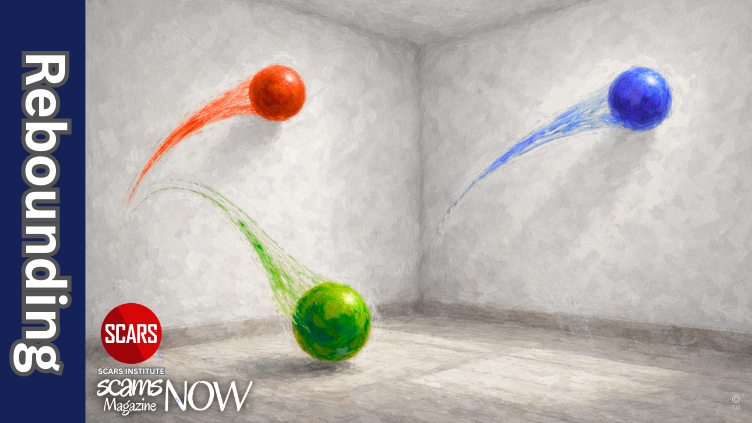


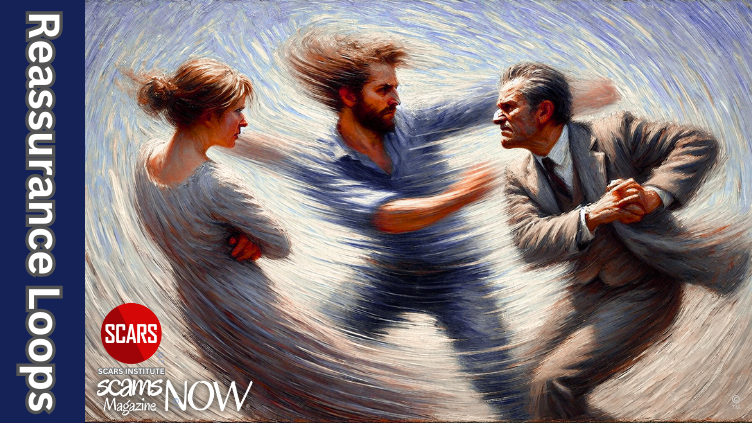


![NavyLogo@4x-81[1] The Doorway Effect - Trauma Makes You Forget So Much - 2025](https://scamsnow.com/wp-content/uploads/2025/04/NavyLogo@4x-811.png)


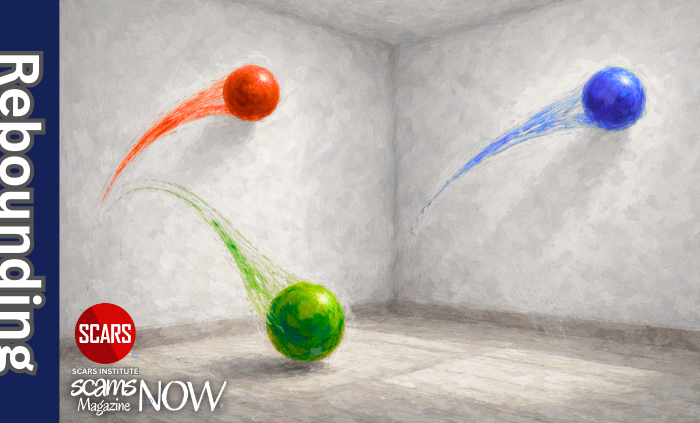

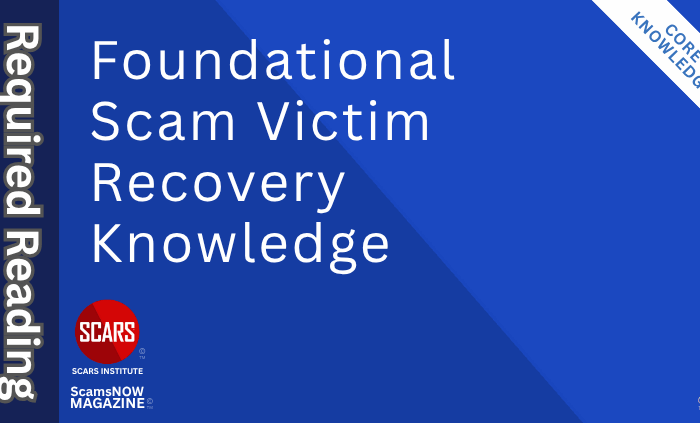

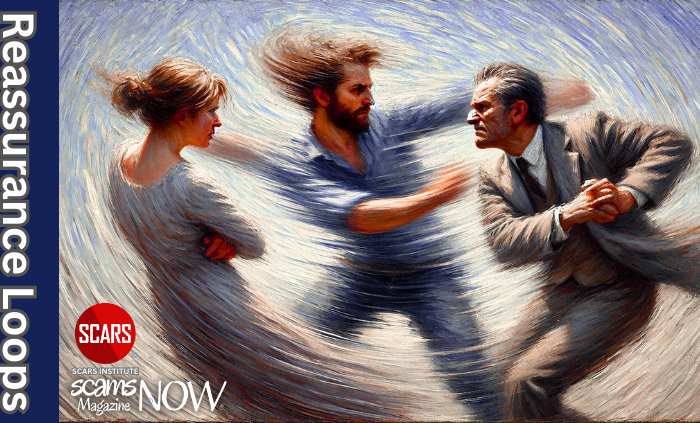


![scars-institute[1] The Doorway Effect - Trauma Makes You Forget So Much - 2025](https://scamsnow.com/wp-content/uploads/2025/04/scars-institute1.png)

![niprc1.png1_-150×1501-1[1] The Doorway Effect - Trauma Makes You Forget So Much - 2025](https://scamsnow.com/wp-content/uploads/2025/04/niprc1.png1_-150x1501-11.webp)

This is a great article. It helps to understand what has happened over the months since my crime ended. Why the triggers, why the feelings and other odd occurrences. They haven’t been often but it is noticeable. This makes sense to me.